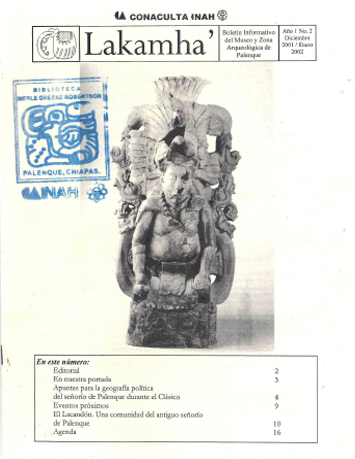Artículos
Publicado 2022-12-21
Palabras clave
- Periodo Clásico,
- Palenque,
- Geografía,
- Política
Derechos de autor 2002 Instituto Nacional de Antropología e Historia

Esta obra está bajo una licencia internacional Creative Commons Atribución-NoComercial 4.0.
Cómo citar
Apuntes para la geografía política del señorío de Palenque durante el Clásico. (2022). Lakamha’, 2, 4-8. https://revistas.inah.gob.mx/index.php/lakamha/article/view/18828
Resumen
No se cuenta con resumen.
Descargas
Los datos de descarga todavía no están disponibles.
Referencias
- Bishop, R. 1994 Pre-Columbian Pottery: research in the Maya Region. En David A.. Scott y Pieter Meyers (eds.) Archaeometry of Pre-Columbian Siles and Artifacts. The Getty Conservation lnstitute: 15-57. Los Angeles.
- Chase, Diane Z .. Arlen F,.Chase y William Haviland. 1990 The Classic Maya City: Reconsidering the "Mesoamerican Urban Tradition". American Anthropologist 92: 499-505.
- Fash, William L., J. 1983 Maya State Formation; A C4Se Study and its lmplications. Tesis. Departamento de Antropología, Universidad de Harvard, Cambridge.
- Liendo, Rodrigo. 1999 The Organization of Agricultura! Production ata Maya Center. Settlement Patterns in the Palenque Region, Chiapas, Mexico. Tesis de doctorado. Departamento de Antropología, Universidad de Pitlsburgh, Pittsburgh.
- López Bravo, Roberto. 2000 La Veneración de los Ancestros en Palenque. Arqueología Mexicana 45: 38-43.
- Rands, Robert. 1973 The Classic Collapse in the Southern Maya Lowlands: Chronology. T.P. Culbert (ed.) The Classic Maya Collapse. SAR / University of New Mexico Press, Albuquerque: 43-62.
- Sanders, Wtlliam T. y David Webster.1988 The Mesoamerican Urban Tradition. American Anthropologist, 90: 521-546.
- Smith, Michael E. 1988 Cities, Towns, and Urbanism: Comentario sobre Sanders y Webster, American Anthropologist 91 :454-461.

